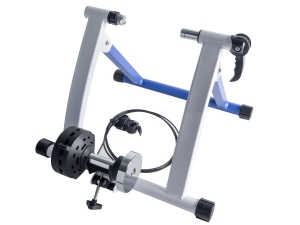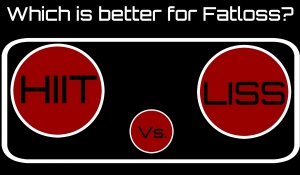This post may contain affiliate links. Please see my affiliate disclaimer for more information.
So if you’re anything like me then after a while of bulking & adding mass, you will start to feel a little fat and overweight. This is inevitable – any time you add weight you will ALWAYS add lean mass & fat. There is no way around it! One way to fight back is by using turbo trainer workouts for fat loss.
Now I’ve tried a few ways to cut back fat previously, but the one I’ve had most success with is doing high intensity interval training (HIIT) by following some simple turbo trainer workouts.
And the best bit?
It doesn’t interfere with your strength training NEARLY as much as most other methods!
Here’s why…
What is a Turbo Trainer, and Why Should I Use One?
A typical turbo trainer is an upside down V shaped prop which you secure your bicycle into via clamps onto the rear axle (known as a skewer) which keeps the rear of the bike elevated off the ground. On the base there is a resistance wheel which can be tightened by screw to but up hard against your bike tire.


You can then ride your bike with the tire rotating the resistance wheel allowing you to simulate a typical ride, but from the comfort of your own home!
Great you may be thinking…. But why would I want to do that?! There are obviously a bunch of pros we can think about:
Turbo trainer workouts offer:
- Saves you money. A simple turbo trainer is really affordable – when you compare this to a full blown exercise bike you will be saving hundreds!
- Lets you train more. I find the thought of getting out on the bike in the rain hard to overcome – with a turbo trainer you can ride no matter what the weather!
- Saves you space. No need to keep a bike and a seperate exercise bike around
- Gives you flexibility to train around other commitments – have a kid? No problem. Want to catch the game? Set up in front of the TV.
So now you’re sold on using a turbo trainer, how do you set the darn thing up?!
How to Set Up Your Turbo Trainer
First things first you need to grab a turbo trainer… I’m currently using this bad boy the YYDE Bike Trainer I picked up for a BARGAIN price off of Amazon.
It has adjustable speed settings, is a universal fit and folds up nice and small.
Deal!
When it arrived it came in a huge box so I was a bit worried… But no problem – pop it open and it’s pre-assembled, in a well packaged box and in a sealed bag. Simply unwrap and fold to open. As simple as that! I was straight on it within 10 minutes and on with my first of many turbo trainer workouts.


Set up takes about 10 minutes if you’re slow like me..
- Take the trainer & bike to the location you want them set up (garage or shed, living room, wherever)
- Unfold the TT and unwind the two clamps that hold the bike so they are as wide as possible.
- Take your bike and unscrew the rear skewer – simply slide the replacement included through the hold and re-tighten. This is a 1 minute job and is easy as hell so don’t be afraid!
- Life your bike up and tighten the two clamps around the rear skewer – screw the fixed side up and check the tightness of fit with the quick release side, tighten the fixed side as required until you get a nice, snug fit
- flip the resistance unit against the tyre and screw the adjuster until the roller is pressing on the tyre making a small dent (as you would normally see on the road)
- put the resistor adapter somewhere on the bike you can reach it – I have mine on the handlebars.
Job jobbed! Now how do you actually use the thing to burn some serious fat?
What Is High Intensity Interval Training (HIIT)?
The full name is fairly self explanatory – but for the avoidance of doubt – high intensity interval training (HIIT) is a workout where periods of super intense bursts of aerobic exercise are interspaced with much lower intensity recovery bursts.


It’s essentially a cardiovascular workout, but instead of a steady, consistent effort (usually known as LISS, or light intensity steady state training) such as distance running it is periodic maximal effort sets – such as sprinting. It therefore makes perfect sense to fit it into a weight training program – think about it – we interspace periods of intense activity doing repetitions with periods of rest between sets.
HIIT therefore is cardio activity, but trained in a fashion we are already familiar with from strength training.
Typically the periods of intense exercise are meant to have a heart rate around 80% of your maximum rate, with the recovery periods around 50% of the maximum. Now the fact most overlook is EVERYONE IS DIFFERENT. I’m not going to base my HIIT workouts on arbitrary maximum heart rates (and not least because I don’t have a heart rate monitor..)
Instead when we do a maximum effort sprint, we will make sure we are truly spinning the maximum possible amount we can do! And recovery is simply a couple notches back, low enough we can consistently spin the pedals with a good cadence.
Why Should I Do HIIT? Is It Better?
There is no hard and fast rule as to what the best way to perform cardio exercise while perusing strength. The population seem split 50/50 between LISS (typically a fasted walk in the morning) and HIIT (as discussed here focusing on the turbo trainer).


What I can do is share my personal motives for adding a dollop of HIIT into my strength routine:
- I don’t want to change my morning routine. Quite simply I like my mornings as they are, and LISS is best performed fasted, first thing. Perhaps if I didn’t have full time work I would follow it, however. (Probably not as you will see from point 2!)
- Workouts are much shorter. HIIT typically is 5-10 “reps” with an appropriate warm up/down, this means a workout can take as little as 15 minutes, or as much as 30 minutes to complete. Even 30 minutes is pretty efficient in my book. I don’t get much pleasure from cardio, so getting in and out as quickly as possible is a huge plus for me 🙂
- Convenience. I can do intervals on the turbo trainer in the garage no matter what the weather, time, feelings etc. It just fits my day better than trying to dart out for a run.
- Cross over with actual cycling. From time to time I do enjoy a leisurely cycle outside, sometimes even with the wife. Training on the TT obviously gives massive cross over benefits to cycling outdoors given I am on my actual bike, in the correct position etc.
[Unreleated]On point 4 it was actually quite interesting doing a few sessions of HIIT on the bicycle I’ve had for a few years I noticed my position was ever so slightly out! I could feel a build up of lactic acid pain not being dispersed correctly in my legs, a simple raise of the seat by 10mm or so and it’s much, much better to ride inside and out![/Unrelated]
Beginner HIIT Turbo Trainer Workouts
So now you’ve unpacked your turbo trainer, got your bike set up ready to go. What now?!
Warm Up: I suggest setting the turbo trainer resistance to its LOWEST setting, and dumping your bike into the lowest gear. This is as easy as it gets. We want to warm up to get into the groove of the thing. Start peddling away at a moderate pace, you will probably want to rack up the gears a little until you find your natural cadence (pedal speed basically). Do this for 5 minutes.


First “On” Rep: As the 5 minute timer approaches, you will want to up the gears on your bike in preparation for the max effort set – I usually jump up around 4 cogs 3 or 4 seconds ahead of the big moment… When 5 minutes of steady warm up have passed, start pedalling like hell. You want to really maximise the cadence (pedal rotations) so push yourself as fast as humanly possible! Keep an eye on the stop watch, count down the remaining seconds…. And breath!!
How do you measure maximal effort? Well as I noted above – we won’t be simply using arbitrary heart rates to do this. We will simply do a maximum effort burst spinning as fast as we possibly can, then a period of recovery where we spin at a reasonable pace consistently for the off period.
Make a conscious effort to remain in control of the bike, you want to be pushing against some resistance, not spinning the pedals aimlessly. If you find you’re cadence is too quick, go up a gear or increase the resistance on the trainer a notch (use the handy handlebar mount for this.)
I will emphasise that pedal pace is key – keep the resistance as low as possible to achieve this, grinding the 30s out is not the aim!


First “Off” Rep: You will have one eye on the watch as it ticks round for 5:28… 5:29… 5:30!! This is your chance to grab a breath. Once 30s passes drop back down a few cogs on the bike back to your comfortable pace – usually around what you were on for the warm up. Keep the cadence consistent, but the effort can be dialled back significantly (think of it has 50% of max effort).
Take 90 seconds of rest between reps of high intensity.
Second to fifth “On/Off” reps: Simply repeat the above two steps until you have completed 5 reps.
Warm down: After the fifth rep take an elongated recovery period lasting another 5 minutes – similar to the warm up.


Frequency per week: We are still training for strength as our primary focus, so I suggest adding in 2 sessions a week on “off” days – I like to do them after the first and last workouts of the week leaving the middle one as true recovery.
How to Progress to Intermediate Turbo Trainer Workouts
I usually advise that the beginner steps above are followed with additional reps added in until you can do around 8-10 reps in total.
At that point start reducing the rest – cut back from 90 seconds to 60 seconds and build back up from 5 reps to around 10. Once that gets achievable (an if question – not when!!) you can drop again to 30s on, 30s off….
There are an infinite number of ways building fat burning turbo trainer workouts – the above is an awesome place to start – Good luck!!
Read Next…
- Deadlift FIRST or LAST? First for me… USUALLY…
- 9 FIXES for an UNEVEN bench press (FINALLY!)
- Is gymming a hobby? Yes, but describe it like THIS instead
- Underhand barbell row vs overhand: Do THIS one!
- My 2x GPP fitness daily workouts (for FREE!)
- 8 SOLID Rogue Echo bike workouts for beginners
- What weight should I start with on bench press?
- What Body Shape Am I & Why Doesn’t It Matter?
- How to Get BIG: My Journey to Adding 50 Pounds of Mass
- Best back exercises for a killer upper body V-shape
- Create the best upper body workout routine – or use mine
